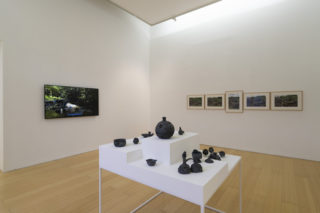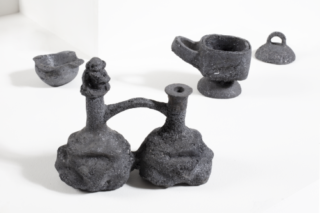
From left to right:
Sebastian Calfuqueo, Kowkülen (Ser líquido), 2020. HD video, 3’28”. Courtesy of the artist.
Ximena Garrido Lecca, Heliomorphism, 2021. Ceramic, solar panels, silicon recycled. Commissioned for ‘Rethinking Nature’. Courtesy of the artist and Galerie Gisela Capitain, Cologne.
Ana Mendieta, Burial Pyramid, 1974/2010. Colour photographs, ed. 4/10. Courtesy of Galleria Nazionale d’Arte Moderna e Contemporanea, Rome.

Heliomorphism (detail) 2021
ceramic, solar panels, silicon recycled
Commissioned for Rethinking Nature
Courtesy of Galerie Gisela Capitain, Cologne
Ximena Garrido-Lecca’s research revolves around processes of resource extraction and land expropriation in Peru and is finely sensitive to the specific qualities and associations of materials and natural elements. Her new body of works Heliomorphism was created through a process the artist developed using silicon from solar panels. The objects are modelled on archaeological vessels found at the Temple of the Sun in Pachacamac, an archeological site located in the Lurin Valley on the central coast of Peru. Significant in Inca culture, the site was the location of a much-consulted oracle and a centre for pilgrimages in the Andes. Garrido-Lecca’s retrofuturist artefacts reflect on concepts of reciprocity in relation to nature in pre-Columbian ritual practices, and shed light on how materials may crystallise cultural values. Heliomorphism evokes the use of such vessels in rites of veneration of the sun, cycles of creation and destruction, and the archeological and symbolic significance of material transformations. The process of developing the work combined the laws of thermodynamics based on the conservation and continuous conversion of energy with a reflection on how to re-enliven longstanding understandings of the human within natural forces, as well as on cultural notions of value in different periods and geographies. Here rather than nature being subjugated to technology, pre-industrial processes are combined with contemporary materials that resignify the relationship with nature.
Artist statement
I have worked with silicon in various projects, I am interested in how this element, which is the second most abundant element in the Earth’s crust, has had an important impact in the technological development since the 1950s. It is widely used as a semiconductor and it defines the way in which we relate with technology in our contemporary world. In my work, I am interested in the notions that surround our relation to nature and this idea of complete respect and veneration found in pre-Columbian cultures, a way of being that is intrinsic to the culture itself. I am also fascinated by the concept of reciprocity in the Andean world: for example, if you take something from Earth you should always retribute in the form of rituals and offering. In this project I take this idea, and use the silicon from the solar panels, which literally absorb and take the sun’s energy, as a material of transformation to create an offering or a sort of gesture of retribution to the sun.